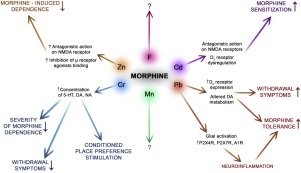Journal of Trace Elements in Medicine and Biology ( IF 3.6 ) Pub Date : 2020-03-09 , DOI: 10.1016/j.jtemb.2020.126495 Patrycja Kupnicka , Klaudyna Kojder , Emilia Metryka , Patrycja Kapczuk , Dariusz Jeżewski , Izabela Gutowska , Marta Goschorska , Dariusz Chlubek , Irena Baranowska-Bosiacka

|
Addiction is a pressing social problem worldwide and opioid dependence can be considered the strongest and most difficult addiction to treat. Mesolimbic and mesocortical dopaminergic pathways play an important role in modulation of cognitive processes and decision making and, therefore, changes in dopamine metabolism are considered the central basis for the development of dependence. Disturbances caused by excesses or deficiency of certain elements have a significant impact on the functioning of the central nervous system (CNS) both in physiological conditions and in pathology and can affect the cerebral reward system and therefore, may modulate processes associated with the development of addiction. In this paper we review the mechanisms of interactions between morphine and zinc, manganese, chromium, cadmium, lead, fluoride, their impact on neural pathways associated with addiction, and on antinociception and morphine tolerance and dependence.
中文翻译:

吗啡元素相互作用–某些化学元素对成瘾相关神经通路的影响
成瘾是世界范围内迫切的社会问题,阿片类药物依赖性可以被认为是最强,最难治疗的成瘾药物。中脑边缘和中脑皮质多巴胺能途径在调节认知过程和决策中起重要作用,因此,多巴胺代谢的变化被认为是依赖性发展的主要基础。由某些元素的过量或缺乏引起的干扰对中枢神经系统(CNS)在生理状况和病理上的功能都有重大影响,并且可以影响大脑的奖赏系统,因此可能调节与成瘾发展相关的过程。本文概述了吗啡与锌,锰,铬,镉,铅,氟,











































 京公网安备 11010802027423号
京公网安备 11010802027423号